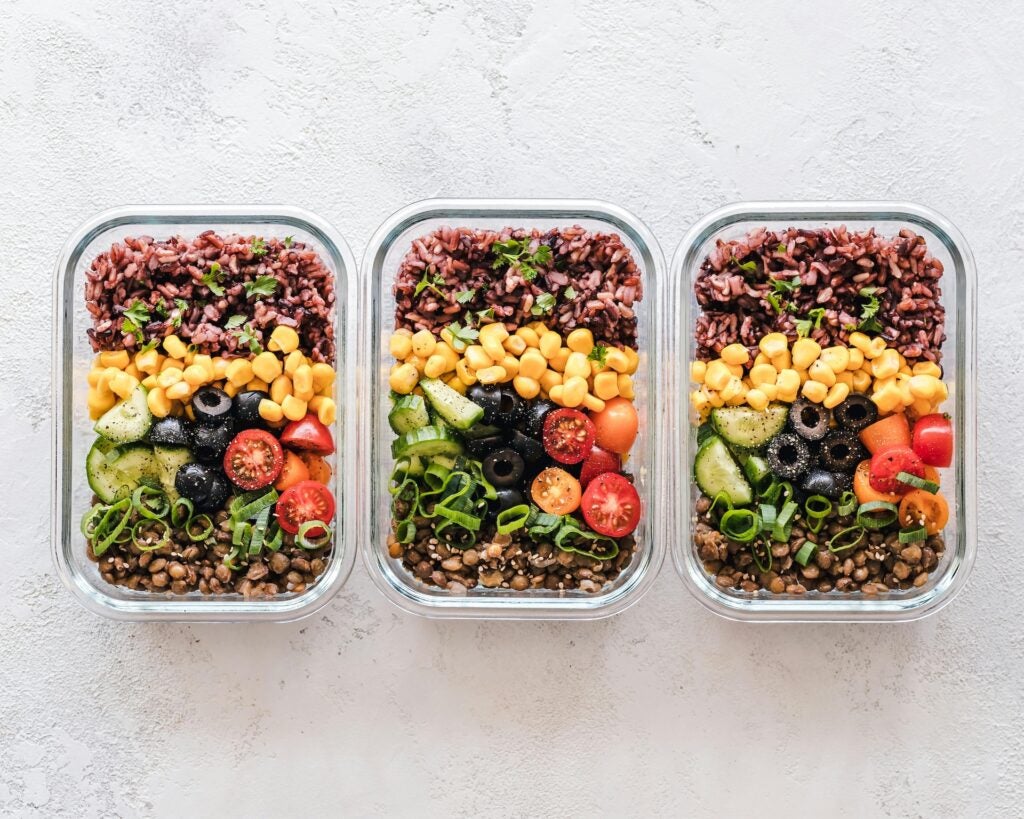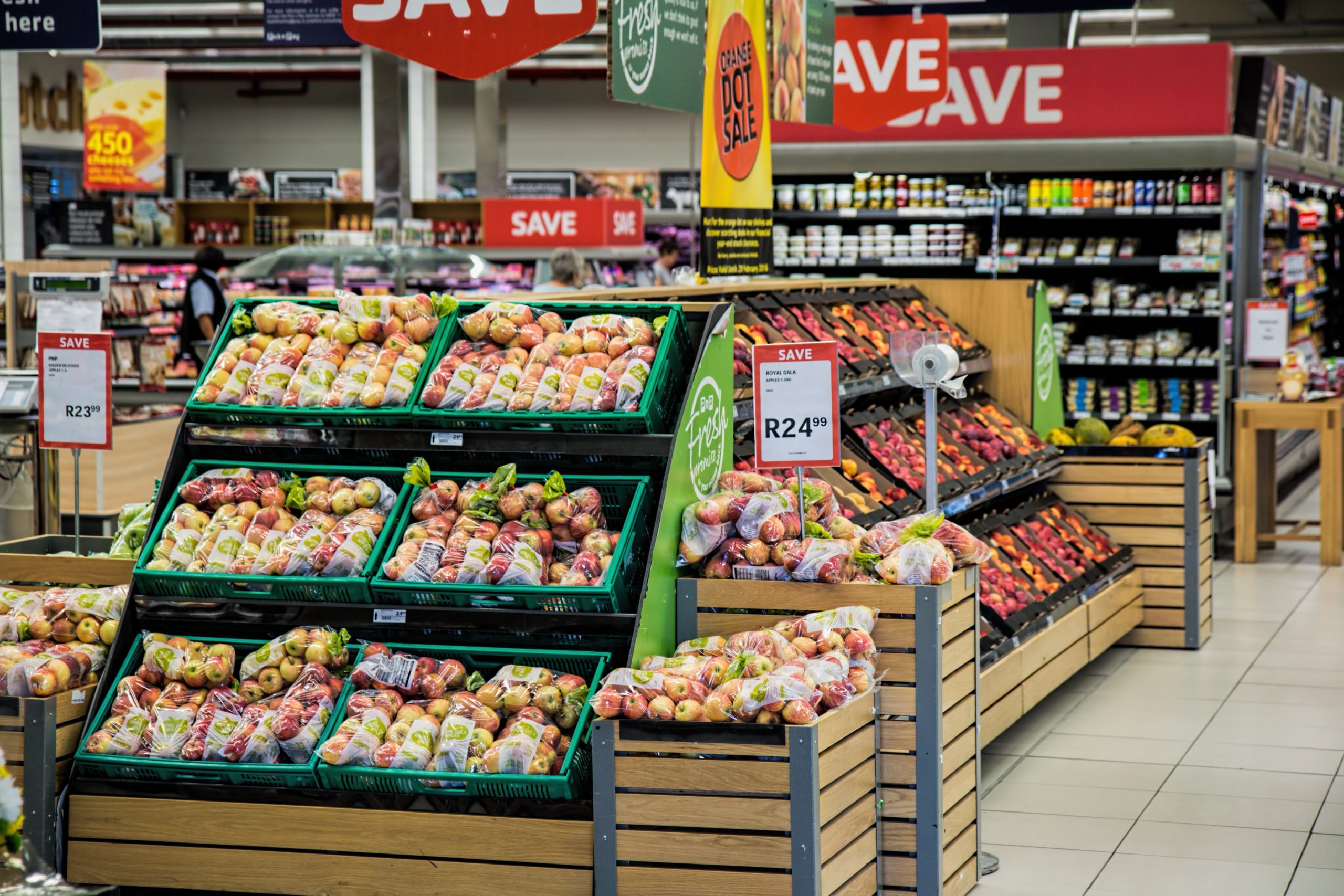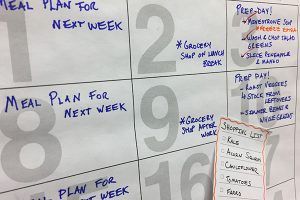
Who hasn’t left work late with a growling stomach but little energy to shop and cook? A busy schedule is one of the top reasons why people choose quick takeout meals, which are often calorie-laden and a contributor to expanding waistlines. [1-3]
Now, imagine a different scenario where within a few minutes of walking through the door you have a delicious home-cooked dinner, and perhaps even lunch packed-up for the next day. Amidst hectic weekday schedules, meal prep or meal planning is a great tool to help keep us on a healthy eating track. Although any type of meal prep requires planning, there is no one correct method, as it can differ based on food preferences, cooking ability, schedules, and personal goals. Here are some examples:
- If you now eat fast food or takeout several nights of the week, your goal may be to choose a specific day of the week to create a food shopping list and hit the grocery store.
- If you already food shop once a week and have basic cooking skills, your goal may be to choose one day a week to do most of the cooking, or try a new recipe.
- If you already cook some weekday meals for your family, you might decide to create a schedule so that you are not deciding last minute what to make and to ensure you have the needed ingredients on hand.
Some benefits of meal prep:
- Can help save money
- Can ultimately save time
- Can help with weight control, as you decide the ingredients and portions served
- Can contribute to an overall more nutritionally balanced diet
- Can reduce stress as you avoid last minute decisions about what to eat, or rushed preparation

Tips for supermarket savings
Prepping for Meal Prep
- Discuss with your family what types of foods and favorite meals they like to eat.
- Start a monthly calendar or spreadsheet to record your meal ideas, favorite recipe sites, and food shopping lists.
- Collect healthy recipes. Clip recipes from print magazines and newspapers and save in a binder, or copy links of recipes onto an online spreadsheet.
- Consider specific meals or foods for different days of the week. Remember Wednesday as Prince Spaghetti Day? Some families enjoy the consistency of knowing what to expect, and it can help to ease your meal planning. Examples are Meatless Mondays, Whole Grain Wednesdays, Stir-Fry Fridays, etc.
- Start small: Aim to create enough dinners for 2-3 days of the week.
Getting Started
 Choose a specific day of the week to: 1) plan the menu, whether week by week or for the whole month, and write out your grocery list 2) food shop, 3) do meal prep, or most of your cooking. Some of these days may overlap if you choose, but breaking up these tasks may help keep meal planning manageable.
Choose a specific day of the week to: 1) plan the menu, whether week by week or for the whole month, and write out your grocery list 2) food shop, 3) do meal prep, or most of your cooking. Some of these days may overlap if you choose, but breaking up these tasks may help keep meal planning manageable.- As you find favorite ‘prep-able’ meals, or your menus become more familiar and consistent, watch for sales and coupons to stock up on frequently used shelf-stable ingredients like pasta, rice, and other whole grains, lentils, beans (canned or dried), jarred sauces, healthy oils, and spices.
- On your meal prep day, focus first on foods that take the longest to cook: proteins like chicken and fish; whole grains like brown rice, quinoa, and farro; dried beans and legumes; and, roasted vegetables.
- Also consider preparing staple foods that everyone in the family enjoys and which you can easily add to a weekday meal or grab for a snack: washed greens for a salad, hardboiled eggs, a bowl of chopped fruit, cooked beans.
- If you prefer not to pre-cook proteins, consider marinating poultry, fish, or even tofu on your prep day so that you can quickly pop them into the oven or stir-fry later in the week.
- Multi-task! While foods are baking or bubbling on the stovetop, chop vegetables and fresh fruit, or wash and dry salad greens for later in the week.
- When you cook a recipe, make extra portions for another day or two of meals, or to freeze for a different week. Be sure to date and label what goes in the freezer so you know what you have on hand.
- For lunches, get a head-start and use individual meal containers. Divide cooked food into the containers on prep day.
Storage
Meal prep can save time and money if you are preparing just enough for what is needed the following week. Refrigeration and freezing are an important step to successful meal planning. However, forgotten food such as produce hiding in a drawer or a stew stored on a back shelf in an opaque container for too long can spoil and lead to food waste. Label all prepped items with a date so that you can track when to use them by. Rotate stored items so that the oldest foods/meals are kept up front. Store highly perishable items like greens, herbs, and chopped fruits front-and-center at eye-level so you remember to use them.
When it comes to freezing, some foods work better than others. Cooked meals tend to freeze well in airtight containers. Foods with high moisture content, such as salad greens, tomatoes, or watermelon, are not recommended as they tend to become mushy when frozen and thawed. Blanching vegetables for a few minutes before freezing can help. However, if the texture of a frozen food becomes undesirable after thawing, they might still be used in cooked recipes such as soups and stews.
The following are recommended times for various cooked foods that offer the best flavors, maximum nutrients, and food safety.
Refrigeration at 40°F or lower
1-2 days: Cooked ground poultry or ground beef
3-4 days: Cooked whole meats, fish and poultry; soups and stews
5 days: Cooked beans; hummus
1 week: Hard boiled eggs; chopped vegetables if stored in air-tight container
2 weeks: Soft cheese, opened
5-6 weeks: Hard cheese, opened
Freezing at 0°F or lower
2-3 months: Soups and stews; cooked beans
3-6 months: Cooked or ground meat and poultry
6-8 months: Berries and chopped fruit (banana, apples, pears, plums, mango) stored in a freezer bag
8-12 months: Vegetables, if blanched first for about 3-5 minutes (depending on the vegetable)
Ready to get started? Below are some recipes that lend well to bigger batches—and don’t forget that the Healthy Eating Plate can serve as a helpful menu planning guide. Happy prepping!
- Farro with Confetti Vegetables
- Vegetarian Shepherd’s Pie
- Cauliflower Tomato Soup with Indian Spices
- Mixed-Up Grains
- White Beans, Wild Rice, and Mushrooms
- Vegetable Stock (great for making use of leftover veggie trimmings)

